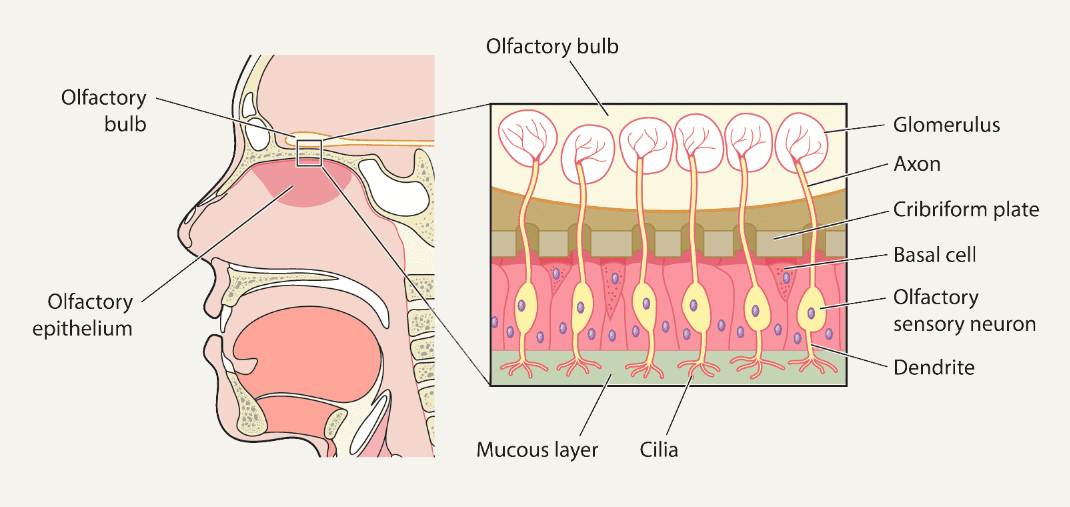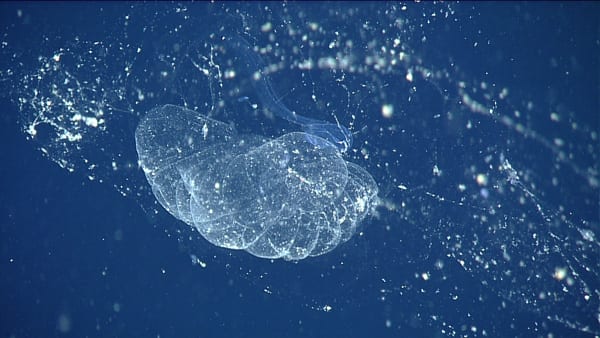Inhaled molecules absorb into mucus in the nasal epithelium and bind with olfactory receptors, triggering a unique code that tells the brain what it’s smelling.
Introduction
Hiking through the Black Hills in South Dakota, you come upon a stand of tall pine trees. They could be ponderosa pines, but it’s hard to tell just by looking from the ground. What do you do? One option is to put sight behind you and smell their bark, in search of the tell-tale scent of vanilla or butterscotch.
Until recently, the human sense of smell was thought to be somewhat weak. Scientists had previously estimated humans could distinguish just 10,000 different smells. That may sound pretty good, but a 2014 study found that we can actually smell up to 1 trillion distinct odors. Humans often lean more heavily on our other senses—especially vision—to understand the world around us. But smell helps us recall memories, augments how we taste food, brings us joy (or disgust), and can alert us to danger.
How does the nose take in molecules from the air and tell our brains what we’re smelling?
The Strategy
Most of the air we breathe through our nose isn’t smelled at all—it proceeds straight to the lungs and gives us the oxygen we need. On its way though, some of it passes over a small region in the top of the nasal cavity called the nasal epithelium.
The air around the ponderosa pines contains some molecules released by the trees’ bark. When we sniff it, some of those molecules are absorbed into a layer of mucus that coats the nasal epithelium. Air flow through the nasal cavity can actually impact the efficiency that molecules absorb into the mucus. The harder we sniff, the more molecules reach the mucus, and the stronger we sense an odor.
Diagram
The mucus itself has several functions important to the sense of smell. For one, it protects the epithelium from drying out. It also contains s that bind with odor molecules. In part, these proteins help absorb hydrophobic molecules that would otherwise be repelled by the moist membrane. Mucus proteins also degrade molecules to clear the way for new scents to arrive. And these proteins transport molecules to special nerve cells called receptor cells, where the actual “smelling” begins.
There, the odor-causing molecules bind with the nerve cells, which directly connect to the olfactory bulb of the brain just above them. While we can register five types of taste (sweet, sour, salt, bitter, and umami), we have more than 100 million olfactory receptor cells that fall into about 400 types.
Scientists believe that each type of receptor cell is tuned to recognize certain molecules. Receptors of the same type “plug into” the same junction (called a glomerulus) in the olfactory bulb. Scientists think that each scent activates specific patterns of receptor cells, which then stimulate a unique combination of glomeruli—like how combinations of letters spell different words—to tell the brain what it’s smelling.
More recent science shows that the glomeruli don’t “spell” words based solely on the structures of the original odor molecules. In 2010, researchers found that enzymes in the mucus convert some molecules into other forms before they bind with receptor cells. Specifically, they found that mucus enzymes change some odor-causing molecules that contain and s into acids and alcohols. As a result, smell signals sent to the brain represent a combination of the original and mucus-altered molecules.
The Potential
We already use detectors to identify airborne chemical dangers such as the presence of carbon monoxide and ammonia gases. However, often each technology is limited to “smelling” just one or a few molecules because they require a particular type of sensor. Mimicking the full array of scent detectors behind how we and other animals smell could lead to artificial intelligence that can sense thousands, or maybe millions, of smells.
Refrigerators might be outfitted with sensors that identify food spoilage to prevent illness. Instead of training people and search dogs to find illegal drugs or explosives, detectors placed around airports could do the work. Ecological monitors could smell the pheromones of animal species to track their locations and migration patterns. Imagine how many lives could be saved if a hand-held device simply smelled cancer tumors?








